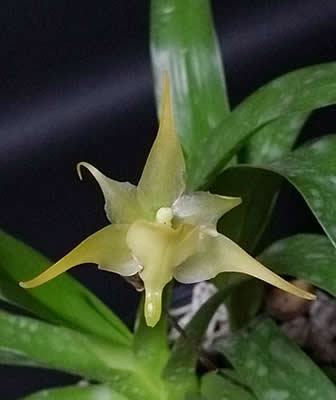The Spider Aeranthes (Aeranthes arachnites Lindley, 1924) is a monopodial orchid, native to the Islands of Madagascar and Réunion. It generally behaves as an epiphyte, growing on tree branches, but can sometimes be found vegetating on rocks (rupicolous). It occurs in forests from sea level up to altitudes of 2625 feet (approximately 800 meters), thriving in a humid subtropical climate with high temperatures in the summers. The genus name “Aeranthes” derives from the Latin word “Aeria,” meaning aerial, along with the Greek word “anthos”, which refers to a flower, thus meaning ‘air flower,’ an allusion to its habit of growing in the higher portions of the forest. The species name “arachnites” comes from the Greek “aráchnē”, meaning spider, referring to the shape of the flower.

This exotic and curious orchid resembles those of the genus Angraecum in terms of monopodial growth. It blooms from the beginning of summer until mid-autumn, and each flower lasts about two weeks. The flowers are yellowish-green and fragrant, with petals, sepals, and even the labellum tapered at the tips. They open sequentially on the same stem until the end of the flowering period and even in subsequent years, so the stem should not be cut unless it dries out. In addition, keikis (aerial offshoots) may emerge on the floral stem while it remains alive, being an important form of reproduction in monopodial orchids. Once the offshoots have a well-developed root system, they can be separated from the mother plant and transplanted into a pot with sphagnum moss.
It should be grown with 50% shading, preferring temperatures between 64.4 to 78.8°F (18 to 26°C), relative humidity of 70 to 80%, and moderate ventilation. The potting mix can be composed of crushed stone or sphagnum moss. A mix of both can also be used. The choice will depend on the watering regime to be adopted. Crushed stone will require more frequent and abundant watering, while sphagnum asks for less intense and more spaced watering, as it has a good moisture retention capacity. As a general rule, the substrate should dry completely between waterings. The surroundings can receive a fine mist throughout the year, as it appreciates high ambient humidity.
A weekly foliar fertilization with a solution of 2g (1 teaspoon) of Peter’s 20-20-20 NPK fertilizer per liter of water is suggested. The foliar fertilization can be daily if this amount of fertilizer is divided by seven for each liter of water, but discipline in application is required. If a day of application is missed, do not apply double the next day to avoid plant salinization. As a complement, perform organic fertilization of the substrate once a month, applying a teaspoon of Orchids organic type fertilizer (like bokashi), sprinkling it on the surface. It is propagated by separating the keikis and by seeding.

